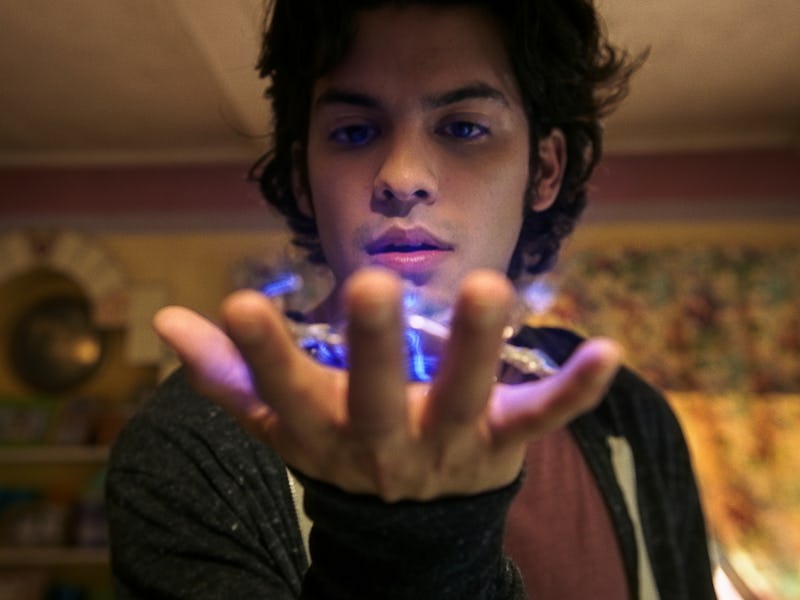Blue Beetle’s Post-Credits Scenes Keep the Focus on Its Hero — But Leaves the Door Open for More
Could Booster Gold reunite with his old friend Blue Beetle? The director explains.

Depending on who you ask, Blue Beetle may be the first entry in James Gunn and Peter Safran’s new DC Cinematic Universe. That would make Jaime Reyes (Xolo Maridueña) the rebooted franchise’s first hero, but one could be forgiven for not knowing that. Over the course of its 127-minute runtime, the movie makes very few specific allusions to the state of the greater DCU. A few comments are made here and there about Superman and Batman, but otherwise, Blue Beetle is one of the more self-contained live-action superhero films that Warner Bros. has released in some time.
That is, for the most part, a good thing. Blue Beetle’s best elements all have little to do with its own greater superhero lore, so the more that it’s allowed to focus solely on the members of its central family, the more that the film succeeds. That said, comic book fans may still find themselves disappointed by just how disconnected Blue Beetle is from the rest of DC’s current and future superhero projects. Although the film’s two post-credits scenes seem to have little to do with the future of the DCU, one detail in the mid-credits scene could set up the introduction of a beloved DC hero.
Warning: Major spoilers for Blue Beetle ahead.
Blue Beetle’s post-credits scenes, explained
Blue Beetle’s mid-credits scene sets up the DCU debut of another superhero.
A few minutes after Blue Beetle gives Jaime Reyes and Jenny Kord (Bruna Marquezine) their happy ending together, the film interrupts its credits by taking viewers back inside the former superhero headquarters of Jenny’s long-missing father, Ted Kord. Once the secret lab has turned back on, viewers hear an audio transmission, which teases the possibility that Ted Kord himself may still be alive. As a matter of fact, the message suggests that Ted has been stranded somewhere for decades, unable to contact his daughter until she, Jamie, and Rudy Reyes (George Lopez) finally turned his Blue Beetle technology back on.
The mid-credits scene sets up a potential subplot for a Blue Beetle sequel, one that could follow Jenny and Jaime as they track down her father. That’d also mean that Blue Beetle 2 would likely see Maridueña’s Jaime team up on-screen for the first time with a version of Ted Kord, the second man to don the Blue Beetle mantle in the comics (Jaime is the third). Whether or not that team-up will ever come to fruition remains to be seen, but in its mid-credits scene, Blue Beetle certainly lays the groundwork for it.
Minutes later, Blue Beetle surprises viewers with one final post-credits scene, which turns out to be another humorous clip from El Chapulín Colorado, a Mexican superhero parody show about a character whose vigilante name literally translates to “The Red Grasshopper” or “The Cherry Cricket.” Blue Beetle, in other words, doesn’t end by setting up a future DCU crossover for Jaime Reyes, but by poking fun at itself one last time and paying homage to its Latin roots.
This all feels pretty self-contained, but could Blue Beetle’s post-credits scene be setting up something big for the DCU?
Could Booster Gold appear? The director explains
Blue Beetle and Booster Gold, BFFs.
While both the mid and post-credits scenes appear to be unrelated to the larger DC Universe, director Ángel Manuel Soto tells Inverse that this is not quite the case (Soto spoke to Inverse for a larger interview that’s coming soon). In fact, the mid-credits scene, which reveals that Ted Kord is still alive, is as close as the movie gets to setting up the future of the DCU.
“In the post-credit scenes, we did want to open up to the idea that there's more to that story,” Soto says. “It's not an open-ended. It’s self-contained, but anything can happen. We wanted to set up something that is very canonical into the life of the comic of Jaime Reyes.”
So what exactly is the story that Soto could be setting up? By teasing the return of Ted Kord’s Blue Beetle, Soto wants to bring in Ted Kord’s best friend: Booster Gold. The two characters are longtime friends in the comics and often team up together. And with DCU chief James Gunn a self-proclaimed fan of Booster Gold, Soto thinks it’s the perfect opportunity to introduce the hero, before his planned TV series.
“We always thought about this before James Gunn came in, but the fact that James Gunn loves Booster Gold and wants to do something with Booster Gold,” Soto says. “We've always been setting up Ted Kord through the daughter, through the conversations and disappearance. Having that mid-credit scene is cool because we don't have to promise nor deny the possibilities of this collaboration.”
Blue Beetle’s post-credits scenes maintain the film’s focus on its Latinx heroes and their cultural roots.
But, refreshingly, Blue Beetle doesn’t betray its standalone nature by overtly teasing a Blue Beetle and Booster Gold crossover. Blue Beetle is a far from perfect film, but its issues don’t stem from how self-contained it is or how little it’s concerned with setting up the future of the DCU. The movie feels perfectly content to let that responsibility fall on the shoulders of projects like Superman: Legacy and it allows that contentment to extend all the way to its post-credits scenes.
Instead, the film concludes with a nod to the Latin superhero titles of the past and a tease of what may lie in store next for Jaime Reyes, Jenny Kord, and the rest of their loved ones. It is, to put it simply, refreshing to see a film like Blue Beetle stick to its own, singular perspective, too, regardless of the place it may hold in the greater history of the DCU.